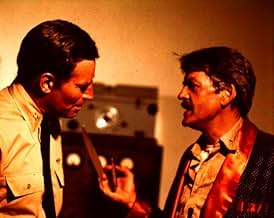Una dramatización de la batalla que fue proclamada como el punto clave en el desarrollo del frente del Pacífico en la segunda guerra mundial.Una dramatización de la batalla que fue proclamada como el punto clave en el desarrollo del frente del Pacífico en la segunda guerra mundial.Una dramatización de la batalla que fue proclamada como el punto clave en el desarrollo del frente del Pacífico en la segunda guerra mundial.
- Dirección
- Guionista
- Elenco
Toshirô Mifune
- Admiral Isoroku Yamamoto
- (as Toshiro Mifune)
- Dirección
- Guionista
- Todo el elenco y el equipo
- Producción, taquilla y más en IMDbPro
Argumento
¿Sabías que…?
- TriviaKevin Dobson's character Ensign George Gay, was the sole survivor of Torpedo Squadron 8. Gay wrote a book about his experiences (Sole Survivor) and was an advisor on this film.
- ErroresWhen the cockpit of one of the planes catches fire, the pilot pulls out a fire extinguisher. It is a more modern one, not a fire extinguisher that would have existed in the 1940s.
- Citas
Vice Adm. Chuichi Nagumo: [commenting on the American torpedo bombers] They sacrifice themselves like samurai, these Americans.
- Versiones alternativasA television version exists, with additional cast and plot. It runs four hours with commercials. The main plot points are a Charlton Heston-Susan Sullivan romance and the Coral Sea battle (reffered to in the other version) is played out like the Midway battle. The Coral Sea battle heavily features Mitchell Ryan as Admiral Aubrey Fitch and also includes a subplot where a young Japanese pilot who'd met with Admiral Nagumo to express his opposition to Japanese military action is shot down. At the end of the TV version, Sullivan and Christine Kukobo are both shown waiting dockside.
- ConexionesEdited from Así es la gloria (1943)
- Bandas sonorasIn the Mood
Music by Joe Garland
Performed by the Glenn Miller and His Orchestra (as Glenn Miller Orchestra) on the jukebox at the bar in Hawaii
Opinión destacada
Of course "Midway" is a flawed movie. The subplot about Japanese-Americans is ridiculous and seems like a forced attempt to be PC during the post-Vietnam 1970s when it wasn't in fashion to be completely celebratory of America. Of course it's unsatisfying that the Japanese actors don't speak Japanese and we have to hear Paul Frees dubbing Toshiro Mifune. Of course the stock footage isn't going to please aviation and naval buffs who know these details like the back of their hands, but to me this is a trivial complaint that fails to take into account the limits of 1970s technology or budgeting. "Pearl Harbor" ultimately got those details right through CGI and the end result was a far worse film in the final analysis. Because ultimately, for all the flaws that are in "Midway" it succeeds because it does stick to the essential truths when telling the story of the battle, and I know this because when I first saw this movie on the CBS Late Movie around 1979, I got so hooked that I went out and read every book on the battle I could find including Walter Lord's "Incredible Victory." The movie had given me a starting reference point and while I was sorry that some key aspects of the latter stages of the battle were not depicted (such as the torpedoing and eventual sinking of the Yorktown), I couldn't have asked for anything better in terms of getting me to learn more about this great turning point of World War II. As far as I'm concerned, it's good that Hollywood did tackle this subject in an era when the influence of "Tora! Tora! Tora!", "The Longest Day" etc. still hung over the proceedings because if it hadn't been made back then, we would today be forced to see it given the "Pearl Harbor" and "Titanic" treatment that is pure garbage.
John Williams contributes one of his finer pre-Star Wars scores with two great themes, the "Midway March" (which is only heard in the end credits of the theatrical version and became more popular in an expanded concert arrangement by the Boston Pops) and the "Men Of The Yorktown March" which dominates much of the score and offers great foreshadowings of the Throne Room sequence in "Star Wars" and the Smallville music in "Superman."
John Williams contributes one of his finer pre-Star Wars scores with two great themes, the "Midway March" (which is only heard in the end credits of the theatrical version and became more popular in an expanded concert arrangement by the Boston Pops) and the "Men Of The Yorktown March" which dominates much of the score and offers great foreshadowings of the Throne Room sequence in "Star Wars" and the Smallville music in "Superman."
- Eric-62-2
- 19 sep 2003
- Enlace permanente
Selecciones populares
Inicia sesión para calificar y agrega a la lista de videos para obtener recomendaciones personalizadas
- How long is Midway?Con tecnología de Alexa
Detalles
Taquilla
- Total en EE. UU. y Canadá
- USD 43,220,000
- Fin de semana de estreno en EE. UU. y Canadá
- USD 4,356,666
- 20 jun 1976
- Tiempo de ejecución2 horas 12 minutos
- Color
- Relación de aspecto
- 2.39 : 1
Contribuir a esta página
Sugiere una edición o agrega el contenido que falta

Principales brechas de datos
By what name was La batalla de Midway (1976) officially released in India in English?
Responda





































